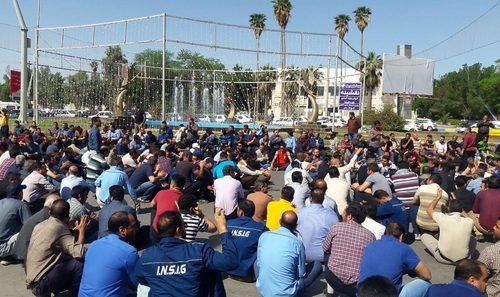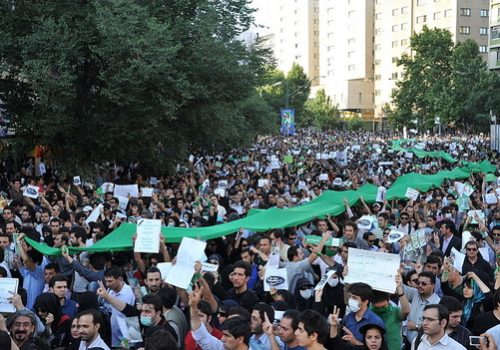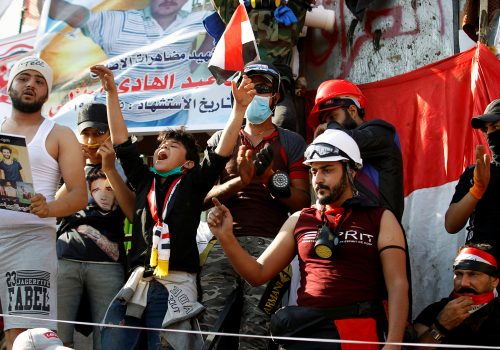Iran protests: A quest for reform turns into widespread discontent
Popular protests are flaring up in the Middle East. From Lebanon to Iraq and now Iran, they show the weakening of the social contract between the population and their government. In the Islamic Republic, the post-revolutionary social contract was born on a populist promises of justice, but decades of endemic political and economic inefficiencies wiped out the implementation of the craved edalat (social justice). Today, disenchanted Iranians are no longer claiming for “justice,” but they express dissatisfaction with the political class, without distinctions of factions and without a programmatic plan of reforms.
On November 15, protests erupted in several cities and provincial towns in Iran after President Hassan Rouhani declared the reducing of fuel subsidies and the rise of fuel prices up to 15,000 rials per liter (12 US cents) from 10,000 for the first 60 liters, and to 30,000 rials for any extra fuel. Considering the high cost of living, an inflation rate of 40 percent, and broad economic uncertainty, this recent decision inflamed discontent among Iranians. Gas stations have been set ablaze and major disorder occurred in at least a dozen cities and provincial towns including Ahvaz, Kermanshah, Shiraz, Sirjan, Yazd, but also sporadically in the capital.
Far from being a massive and organized gathering, the recent protests in Iran are part of a monthly based phenomenon of loud discontent which erupt in different regions and involve mainly low-middle classes. These protests are indicating not only the actual dissatisfaction, but also how social disagreement is changing. Beyond the thorny and more current question of fuel subsidies, the recent demonstrations reveal a change in the popular claims and actions, whereas the political elite looks increasingly distant from the needs of the population. In the last decade, starting with the 2009 post-election protests known as the Green Movement, recurring moments of demonstrations took place with discontent mainly from economic difficulties. For instance, since December 2017 and during 2018, several protests erupted from different workers categories—from truck drivers to teachers, to factories workers—due to delayed pay check, job insecurity and low salaries. Having that been said, the Green Movement has been the last massive movement that openly condemned the post-revolutionary elite. Moreover, it was supported by a political faction, that is absent now.
Far from being a massive and organized gathering, the recent protests in Iran are part of a monthly based phenomenon of loud discontent which erupt in different regions and involve mainly low-middle classes.
Nowadays, the protests are confronting the whole government—as the current demonstrations show an anti-system animosity. They are characterized by apolitical tones, and no faction within the government is “spiritually” leading the discontent, which means an increasing distance between the people’s demand and structured political plans. Moreover, the people and the government have no interlocutors, which also indicates how Iranian politicians have moved away from “the streets”. Before, a specific group of the population was asking for limited openings, political participation, individual liberties, and small reforms rather than to prefer chaos. Today, the protests are less socially elitist and demand for: economic security, access to goods and services, unemployment, lack of job security, privatization policy, the high cost of living, and low salaries. Protesters are even demanding for Rouhani’s resignation.
It is worth mentioning that subsidies on fuel as well as on other essential goods, established the basis of post-revolutionary Iran based on the equitable distribution of resources and welfare. However, several factors have made the subsidies structure unsustainable. Among them, the demographic growth (now at 82 million people), the lack of efficient political economy, combined with the pressure of US sanctions—which were re-imposed after the unilateral withdrawal of the United States from the Joint Comprehensive Plan of Action (JCPOA) in May 2018. The so-called pragmatic and reformist governments of the 1990s failed to promote adequate subsidy reforms, and yet the problem remained evident and in need of solution. In 2011, President Mahmoud Ahmadinejad’s subsidies reform sought to reduce fuel subsidies while providing monthly cash payments to poor families. It ended up alienating the subaltern and provoking drop-down collateral effects on the inflation rate and level of corruption. As Ahmadinejad’s claim was to help the poor, incumbent President Rouhani—after a long-lasting attempt to reduce subsidies inefficiency to rebalance the government spending—declared the fuel price increase will serve to further benefit the interest of those who are under pressure. This backfired quickly as people started taking to the streets.
In response to the protests, Supreme Leader Ayatollah Ali Khamenei openly supported the government’s decision, even though he distanced himself as “a non-expert” on the subject. Khamenei also tacitly endorsed the violent repression against the “hooligans” for their “act of sabotage,” while receiving encouragement from Iranian opposition groups in the west. The internet was promptly cut-off—in order not to circulate protest images within and outside Iran—and thus far there are reportedly a thousand arrested and at least twenty deaths in the clashes.
This geography of discontent indicates how widespread economic and political grievances are linked to diverse social classes—such as low-income households, workers, unemployed youth—but also peripheries and major cities of the country. Still, the violent repression suggests political uncertainties. In February, the parliamentary elections could register a low turnout, a critical signal for a system that has always based its popular legitimacy on elections. Although the reduction of the upheaval is essential for the nezam (system) to maintain control over the country, the crackdown on demonstrations could further fuel the popular discontent.
Giorgia Perletta is a professor of Iranian history at the Graduate School of Economy and International Affairs (ASERI) in Milan, Italy.
Image: People protest against increased gas price, on a highway in Tehran on November 16, 2019 (Reuters)



